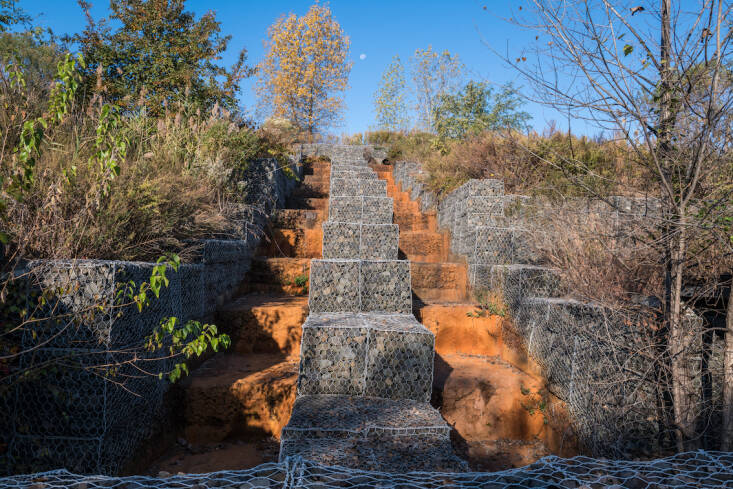Unless you’re from Staten Island, chances are you’ve never been to the borough, except to take the ferry there to see the Statue of Liberty in New York Harbor, only to turn around again. Even its moniker, Borough of Parks, is not well known, but it’s well-deserved, since one third of Staten Island (which is bigger than Manhattan, just across the Hudson River) is devoted to park land. A good chunk of that, Gateway National Park, was saved as green space by a local congressman, and the newest park, Freshkills, is run by his son, Mark Murphy, as part of New York City Parks.
Below, Mark explains how Freshkills, once the site of the largest landfill in the world, is now teeming with wildlife, including migratory birds and iconic American birds of prey. And we learn a bit about Staten Island along the way.
Photography by Valery Rizzo for Gardenista.

Freshkills covers 2,200 acres, 814 of which is wetland that is named after the Staten Island naturalist William T Davis. “It’s reclaimed land that Robert Moses, the first parks commissioner, was trying to dump on, and it was ultimately turned into a park,” says Mark, a fourth generation Staten Islander. “That sort of reclamation was always here in Staten Island.” Moses did succeed in “filling in” what is now North Mound, originally intended to accept household waste for three years to make the land more solid for development. Seven years in, it was the largest landfill in the world. North Mound consists of compacted solid municipal waste that at its highest point is taller than the Statue of Liberty. It marks Phase One of the development of the whole site into what Mark predicts will be New York’s biggest park.

Landscape architects James Corner Field Operations (of Highline fame) won the competition to reconfigure the site; it is slowly being developed and opened to the public in stages. The periphery is open to all (“it’s a fantastic amenity for the communities of the southwest shore of Staten Island,” Mark says) while North Mound Phase One, adjacent to the wildlife refuge, is a 30-acre site that is accessible through group events.

“One percent of the entire native grassland area of the Northeast United States is in Staten Island,” says Mark. “In native grasslands, a city of animals and life is under the grass, and they all feed off of each other in this great ecosystem.” Tree roots don’t get very far in the geotextile that forms part of the capping of the landfill, so they do not become big.

“We have no problem encouraging any type of wildlife to come into Freshkills, whether it’s a plant or an animal,” says Mark. “The fauna and flora out there are incredibly robust.”

“It’s interesting because you see some some significant evolutionary changes in the sounds that toads make, and birds make, during the mating season to compensate for the sound of cars and and background noise,” observes Mark. “They improvise, and they are becoming stronger out there.”

“We’re seeing the sedge wren come back, grasshopper sparrows; bob whites are making an impression,” says Mark. “We also have other wildlife that is not problematic but ‘interesting’: in Staten Island we have wild turkey, and they’re more of a woodland species. And then we have red fox, which are more grassland. Their habitats are not overlapping, so we’re not seeing the fox thin the turkey flock. There are too many of both, but it will fall back into parity with time.” There is also a “huge” population of white-tailed deer. A coyote den has been spotted at Freshkills, so the balance might be on its way to changing. There are wild turkeys all over Staten Island.

The “best-in-class” engineering at Freshkills ensures that the gases and toxins captured from decomposing waste are processed at a flare station, via an underground network of pipes—between the compacted garbage and a serious geotextile. The latter covers the whole site; it is a durable cap. Clean soil has been spread over that at varying depths, while over the whole site there is a guaranteed top two feet of “parks residential grade soil.”



“This landscape has to be a grassland,” says Mark. “It is not a necessity to have tree canopy out there and it never was. The Lenape people [who were here originally] would hunt, and they would forage in these forests, but they called this the ‘Place of the Bad Woods.’ The woods weren’t good because they were growing out of wetlands.” He points out that grassland is far more efficient than trees at storing carbon in its long roots; it doesn’t give the carbon up to the atmosphere in the way that a tree does when it is chopped down.

Keeping the land in place, covering the landfills, is clearly a priority. “The entire site has been designed to prevent any type of erosion,” says Mark. “When there’s a storm, the water pours into gabion walls and steps, that are erosion runoff areas. This helps the water that comes off the mounds go into the drainage ponds.”

The scope of Freshkills goes beyond the that of more traditional city parks. “It’s an entirely different sort of mindset than we have out here, which is really about getting this built, and making this inevitable. Freshkills will be the next great park in New York City, and the inevitability of that is what I want to ensure.”
See also:
- Bringing Biodiversity Back: A Conversation With the Director of Horticulture at Governors Island
- Fresh Food on Far Rockaway: The Case for Urban Farms in Food Deserts
- Nature’s Defense: An Abandoned Former Military Site on the Rockaway Peninsula












Have a Question or Comment About This Post?
Join the conversation (0)